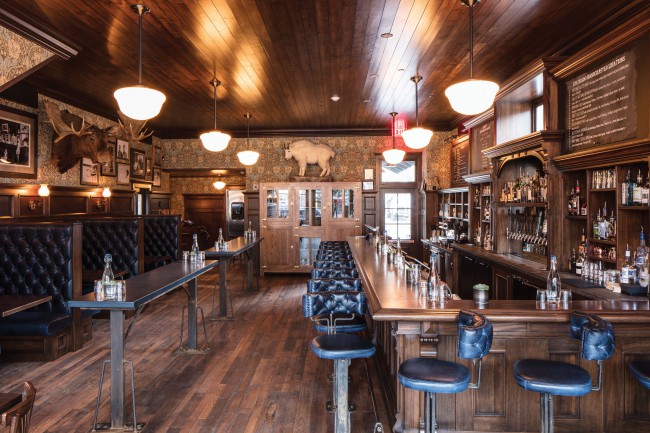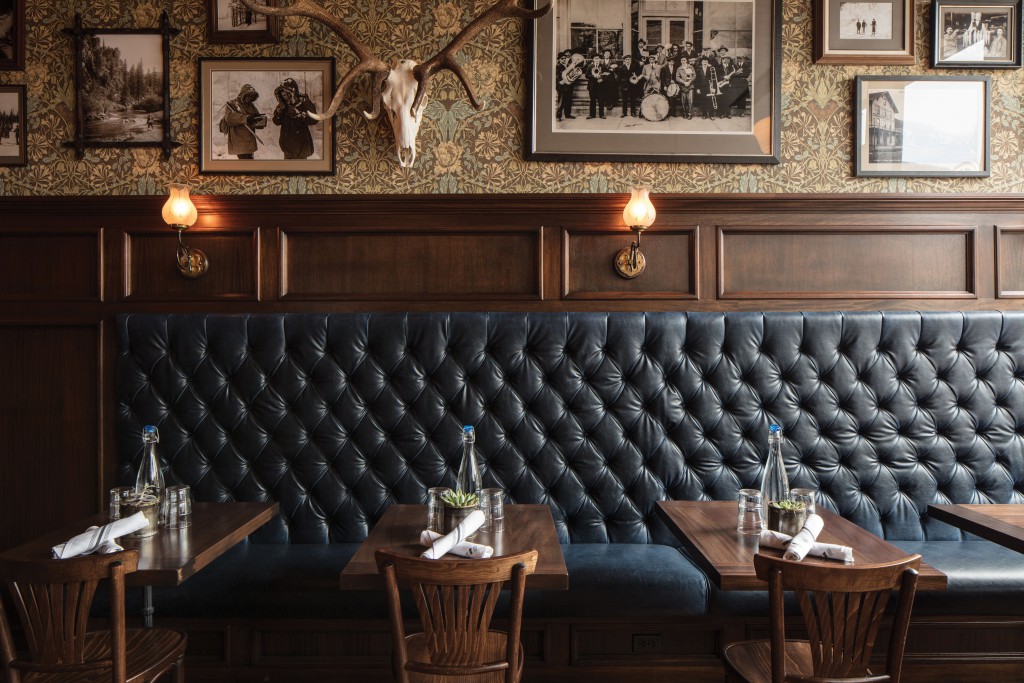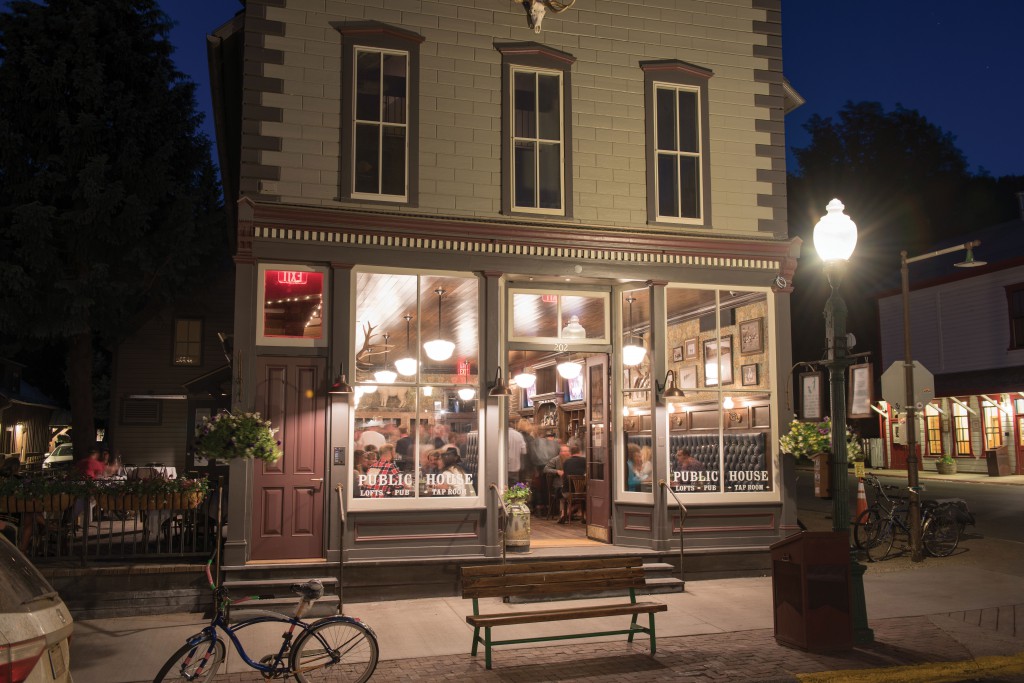

BOZAR’s 2017 Project of the Year Resurrects a Fixture of Historic Crested Butte.
By Seth Mensing | Photos by Alex Fenlon
S
When you walk into the barroom at the Public House at 202 Elk Avenue, you can look above the booths opposite the bar and see an old black and white photograph of some of those people standing in the same room as it was a century ago. Derby hats and dingy suit jackets adorn the men and a small child in a long dress sits on the foot-rail, bookended by two spittoons. But when you look a little deeper still, you can see the bar in the photo is remarkably similar to the one the bartender stands behind today. It’s not by accident.
When the owner’s representative, John Featherman, took on the rehabilitation project that would give new life to a building that had been a fixture in the town’s historic district, he knew the outside would have to stay the same, not just similar. He would need to meet all the requirements set by the Board of Zoning and Architectural Review (BOZAR), whose mission is to preserve the town’s historic feel.
He also knew the work wouldn’t stop there. The Public House was the vision of Chad and Blake Pike, owners of Crested Butte-based Eleven Experience, which operates Scarp Ridge Lodge and Taylor River Lodge (both in Gunnison County) and has other lodges in Europe and South America. The Pikes wanted to create an intimate high-quality music venue that would bring talented artists to town.
“We’ve created a place to be enjoyed by locals and guests for centuries to come, which is something I am very proud of.”
The company’s exacting standards meant the Victorian look on the outside of the building would need to be met with the same styles and textures inside. And beneath the ornate wallpaper and mahogany, the building’s construction and mechanical systems would be state-of-the-art. Adding to the degree of difficulty, the reconstruction would include the addition of a basement where none existed before and the second floor space would be converted from office space into three well-appointed lofts.
To help turn the owners’ vision into construction, Featherman turned first to architect Dan Murphy and engineer Dodson Harper of Crested Butte-based Resource Engineering Group. Then he brought in general contractor Scott Hahn of Cedar Ridge Construction and Hahn’s right-hand-man Michael Luna, who together have a half-dozen historic reconstructions under their belts. But the task ahead would still be a challenge for everyone involved.
The building had been an important part of the business district since the town’s earliest days and, according to the historical record, is one of the few buildings unaffected in either of Crested Butte’s major fires, in the 1890s. It was originally built in 1882 in the 300 block of Elk Avenue as a boarding house and saloon. A map from 1898 shows the building where it is now, moved there after the building previously on the site burned down five years earlier.
From the late nineteenth century until 1930, John Rozich operated a bar in the building until he passed it down to his stepson, Ed Rozman. Ed ran the establishment, known as the Elk Head Bar, named for the record bull elk mount that hung on the wall, until 1957. After the bar closed, the building remained a residence for the next 30 years until Rozman sold the building and it served as a retail shop.
When the building was bought in 2013, town historic preservation coordinator Molly Minneman says, “The building wasn’t feeling very well.” It was tilted nine inches from front to back and leaned six inches from right to left. The stacked stone foundation the building sat on was sinking into the ground and the logs the entire structure once rested on had largely rotted away. But it still stood against the elements.
The first order of business was lifting the building so the basement could be excavated and a proper foundation poured. To do that the team would need to square and brace the building and cut holes in its walls big enough to slide long steel beams through. Using their time-tested method for lifting historic buildings, Vogy’s House Moving of Montrose lifted the entire structure four feet off the ground to allow the excavation to proceed.
The first step in digging a 14-foot hole just a few yards from Coal Creek was finding ways to reinforce the walls so they wouldn’t cave in on workers as they removed tons of dirt and rock. This meant establishing a line of defense with some 225 concrete micro-piles around the building’s perimeter. Several additional holes were excavated outside the basement area and pumps installed to remove as much water as possible before it could seep into the work space.
“For six months we had these pumps and hoses pumping the water out of the ground and back into Coal Creek,” Hahn says. “We had pumps down in the hole too, because as we were digging there would be water just running out of the walls.”
A concrete slab a foot thick was poured and an elaborate basement wall system was devised to keep the water at bay. “We basically made the hull of a boat in reverse,” Hahn says. When they shut off the pumps, the groundwater returned, climbing about eight feet up the foundation wall. But almost a year to the day after starting the first phase of construction, the walls were holding and the team prepared to set the building back on the ground.
With wall studs that extended the entire height of the building and a base that was rotten throughout, the team set to work cutting the studs, which were 2×4 dimensional lumber instead of the 2×6 lumber that would be standard today, to a uniform length and replacing the sill plate that would sit on the new foundation.
As the building and the foundation came together, the team watched with anticipation. “We listened to the building creak, and when it came down it was still a little wavy, but a lot more straight than it was, which was pretty amazing,” Cedar Ridge’s Luna says. Today you’d have to look hard to see any wave at all.
At that point the owners had, for the most part, met the town’s requirements and could have finished the interior as simply and quickly as possible. The windows had been refurbished and the front stoop, complete with a snowmelt system, was nearly indistinguishable from the original wood. But they were only halfway done. For the next 12 months a team of nearly 40 subcontractors, all experts in their respective fields, worked long days around and over one another to get the job done.
“The overall experience was incredibly rewarding,” Featherman says. “Our development team took the time to hone the Pikes’ vision, work with the town and engaged a talented team of local craftsman to rehabilitate a piece of Crested Butte’s history. We’ve created a place to be enjoyed by locals and guests for centuries to come, which is something I am very proud of.”
When you walk into the barroom of the Public House today, it’s a feast for the eyes, rich with dark mahogany wall panels, sumptuous blue leather upholstery, reclaimed wood floors and custom ironwork from Crested Butte-based Blackstar Ironworks. Immaculate custom trim work, modeled on the original bar, extends from baseboards to crown molding and every detail in between and then continues through the entire building. All together the place feels like it was put in storage a century ago and spruced up just for us to enjoy today.
The refurbished building’s original design had a kitchen in the basement, which had been so elaborately engineered and executed that they saw a higher purpose for such a unique space. Eventually they imagined a cutting-edge performance venue, complete with state-of-the-art sound and lighting and a ventilation system that keeps the temperature perfect for 140 dancing fans. In the back patrons are served drinks over the original bar, the same bar featured in the photograph upstairs.
The music venue was inspired by historic New Orleans venues with a tradition of live music such as the Maple Leaf and Tipitina’s. “If you haven’t seen a show in here yet, you should,” Featherman says. “The focus on sound quality and design provides an amazing live musical experience that both fans and musicians appreciate.”
“Somebody could say, ‘Well, it really doesn’t look that much different.’ And in a way they’re right. But that just means they did a really good job.”
Tucked away in the back of the building, an elevator takes guests upstairs to three private lofts, while a stairway gives them private access to Elk Avenue. The rooms are bright, with light pouring in through the big, original double-hung windows. They’re plush and comfortable with the texture of reclaimed timber trusses and rich woolen wallpaper.
Featherman says, “What I really loved about this project was that each floor has a unique space with different style and function elements; from a Western saloon, to an urban music venue to a high end lodge and each seamlessly existing under one roof.”
When the project was completed and opened for business on July 3, 2017, it was clear that the rehabilitation was a smashing success. BOZAR chose it as Project of the Year for 2017 and the reconstruction added another 150 years of useful life to a building that was on its last legs.
“They did such a fabulous job,” Minneman says of the building’s rehabilitation. “Somebody could say, ‘Well, it really doesn’t look that much different.’ And in a way they’re right. But that just means they did a really good job.” •




